
How do you teach a student how to read well?
Good curriculum is a tool which can help guide the process and good readers can help provide the main material(s) to practice these skills!
Teach reading by reading things of interest to the student!
Sometimes “reading curriculum” mainly tries to teach this skill by having a child write words over and over. (That’s dull!)
Sometimes reading programs mainly try to teach this skill by reciting lists of words or even nonsense sounds. (That’s boring!)
Sometimes reading skills are mainly taught with quietly manipulating letters by copying patterns. (That can be frustrating especially if it’s with those little bits of flat paper letters that are hard for little fingers to pick up!)
Some families try to teach reading by mainly having the child(ren) listen to the parent read aloud. (It takes patience and more time to listen to a beginner read.)
But the main focus of teaching a child how to read, should be for the child to actually read, and read things of interest to a child!
Readers?
“Readers” are different than “picture storybooks”. The authors (e.g. people who are teachers or literacy specialists) purposely arrange the words in the book in such a way as to try to teach children new vocabulary while providing practice for other common words and sounds. A “picture storybook” can be of course used for practicing the skills of reading but it might use less repetition of words for practicing and instead, have a focus of introducing concepts through a visualized storyline rather than teaching “how to” read.
Teaching a child to read using a “reader” is also different than using a “piece of literature” that has not many simple sentences (or none), no pictures to help with vocabulary concepts, and less repetition of new words. Yes, you teach a child to read with pieces of upper-level-sentenced literature, and some homeschoolers try it. But I don’t recommend limiting reading lessons to this unless you’re in a situation where you cannot get books with simple sentences and pictures with which to begin and use until the student is readily fluent and eager to move onto fewer pictures and more complex sentences.
Using “readers” makes the task of teaching and learning to read much easier and generally quicker!
Most homeschool moms would love to find ways to cut down on the time and energy that teaching takes if it is also effective and fun for their kids. Using readers to help teach reading skills is one of those ways!
Old-fashioned schoolteachers in the 1940s to 1980s found that readers helped many students of varying backgrounds and abilities, to learn how to read, and to read well. Many times these were “story readers”. Sometimes they used “phonics readers”. In more recent decades, the “integrative-based readers” became more popular – these have some benefit however I think the other two kinds are more overall effective in literacy skills in comparison. But think of the numerous senior adults who look back to their school-days and appreciate the memories of those old [story] readers! Talk about impact!
(I mention this again at the bottom of this page but here too – we have a printable of a partial list of “old story readers” that you can download here: Old Readers List2020. You might be able to find the old titles at yard sales or used book sales or online. We only sell new books. But some of the vintage story readers have been reprinted in recent years and we’ve included some of those in our product-line.)
The following is taken from an old hand-out I gave at one of my seminars. It describes the three kinds of readers (books) which parents and teachers often use when teaching children who are beginning to read.
Phonics Readers
One kind is a phonics-based reader that uses groups of phonetically-similar words to practice.
Some phonics readers are only sentences of rhyming words (“word families”) or words with the same initial sounds written in grammatically-correct sentences but without meaning to a plot line of a story. For example, one page might say something like, “Dan ran with a pan.” And the next page might say something like, “A fat cat sat on a mat.” These are just bunches of disjointed sentences repeating similar sounds together and these readers can be quite boring.
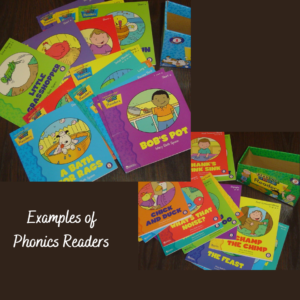
However, some phonics readers use these same types of words together AND make an interesting story with them! So try to use books with interesting storylines (even very short meaningful stories) rather than the type with unrelated sentences strung together in a paragraph.
My favourite series of phonics readers are pictured here but are “out-of-print”; we might have a set or so still in our SHOP.
Pre-Emergent/Emergent/Integrative-Based Readers
Another kind, one I call an “integrative-based reader”, is a one-topic or one-event reader in a single thin book. In this kind of “reader” are simple sentences which often make up an interesting story or organized information on that single topic.
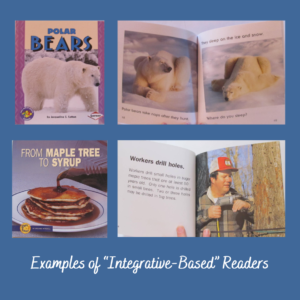
The words are not related in phonetic groups, nor are they always repeating specific sight words. Rather, there is a variety of a dozen or more new words which a child is taught to read or guess what the word is, given the context of the story and picture.
For example, to read a word that begins with “s” on a page with a picture showing a bear sleeping, a good guess would be “sleep”. To read a new word that begins with “dr” and ends the same as “hill” on a page showing a drill, a good guess with observing this context clue is “drill”.
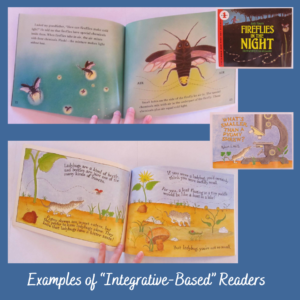
The topics in these type of “readers” often relate to other subjects a child is studying in that grade level, for example, in science, social studies, or math.
Sometimes they may be listed as “literacy readers” or “books for pre-emergent or emergent readers” but the general description of these single thin books is that they integrate learning to read with other academic subject areas. (Different publishers seem to have their own standards as to how easy or difficult their levels of vocabulary are, although there are some similarities – see the pictures as examples of levelled readers we have sold.)
Having a handful of these kind of books available for children to read can also be a great idea, helping them learn to read using context skills!
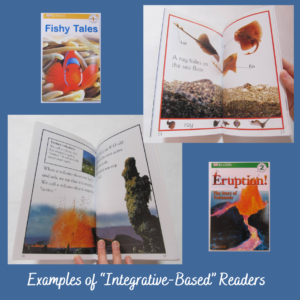
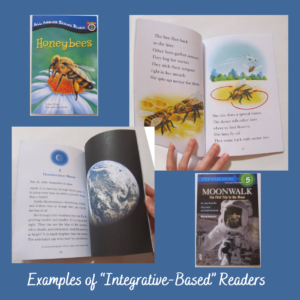
Also, boys might especially appreciate these kind of readers (since these books tend to be non-fiction and in my understanding, boys tend to like non-fiction more than fiction books).
We might still have some of these kinds of readers in our SHOP. Check each category of interest (science, socials/history/geography, math). You might also check our LISTS page for Character-Building Titles for Children since some would be listed there.
Story Readers
And then there is my mom’s favourite kind of reader, which we call a story reader (or just referred to in “Let Me Read” as a “reader”). Even though I recommend using all three kinds of readers within your school lessons, this is one of my favourites as well!
This is the kind which has words arranged into an interesting story. The words are repeated often throughout the story and entire reader.
Both phonics and sight words can be taught from this kind of reader, using topics from a variety of subjects of interest to children and reflects ordinary thoughts and experiences of childhood.
My mother was a well-loved old-fashioned schoolteacher who specialized in the area of literacy (“how-to” read). She thought it was more motivating and exciting for the children to start right away at the beginning of the school year with actually reading sentences and complete stories by themselves rather than waiting until later on in the year. So she’d begin the school year with this kind of reader, supplementing with various picture storybooks, poetry, and articles as time went on. But the “story reader” was a “spine” to the kind of literature she used to teach children how to read – whether in the classroom, in tutoring situations, or in homeschooling my sister and I before we entered public education.
This kind of reader was commonly used in the 1940’s to 1980’s and some have been reprinted again. The stories often feature children and sometimes animals which may be “old fashioned” but still relevant enough. Children still like reading about families and their adventures even if in a setting from the past! The stories often show good character traits such as kindness, helpfulness, gratefulness, etc..
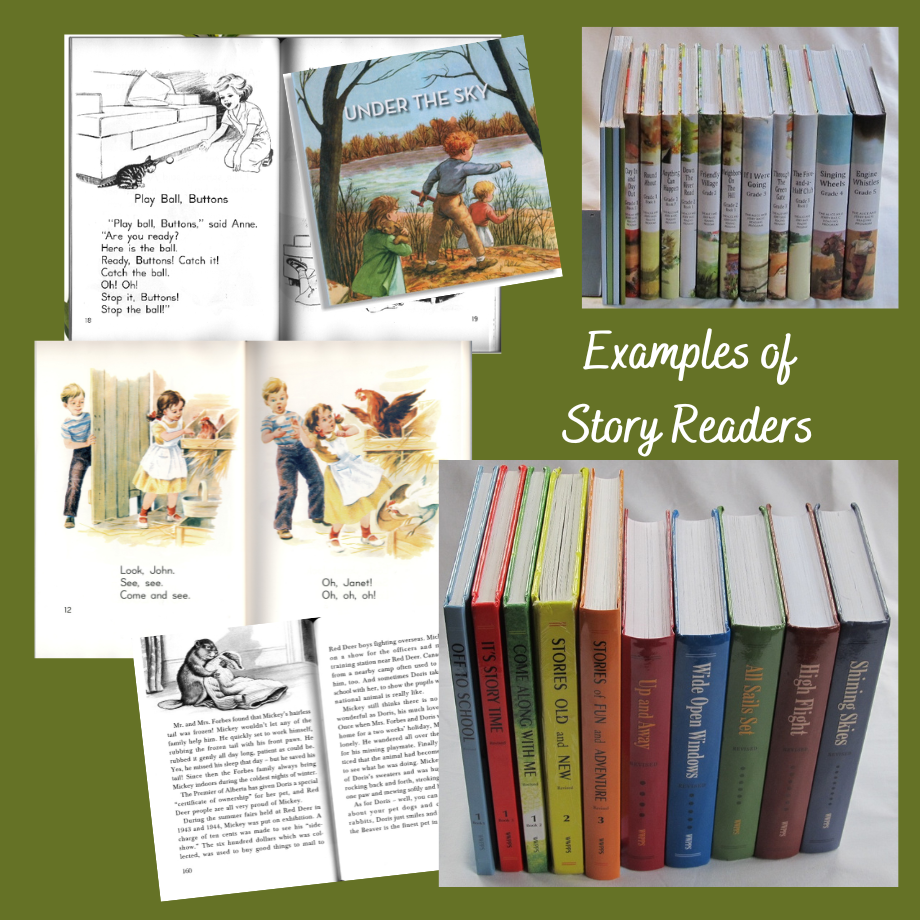
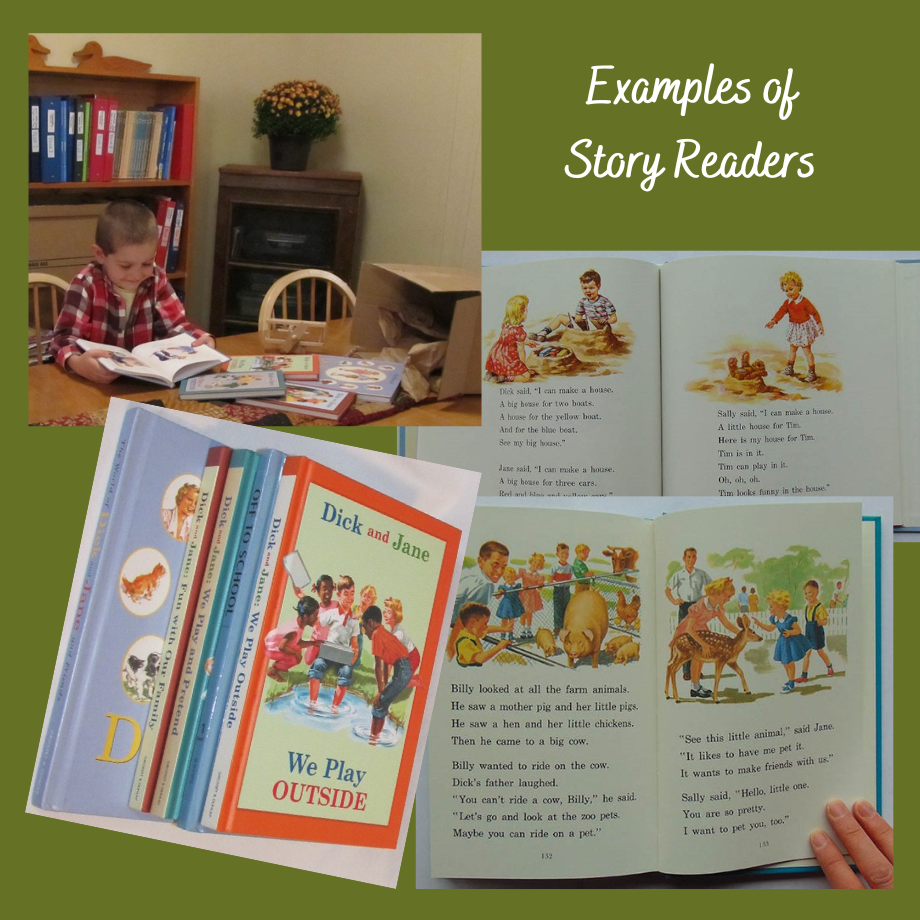
For your interest, we have a partial list of “old story readers” that you can download (free, pdf format) by clicking here: Old Readers List2020
When Choosing Readers…
- Try to find readers that have interesting stories with action in them (i.e. remember that a good story has a beginning, middle, and end to it) rather than the kind that just puts words into sentences or phrases to describe a picture or event on the page, followed by a page that has no relationship to the previous page.
- Also look for readers that bear some kind of resemblance to how we (young children or adults) verbally tell a story (talk) in normal daily life.
- Readers that keep the same (or similar type of) characters throughout the reader series can also be helpful to children. It motivates them to find out “what next” happens to the characters they have just read about.
Remember, it’s better to practice reading by reading!

